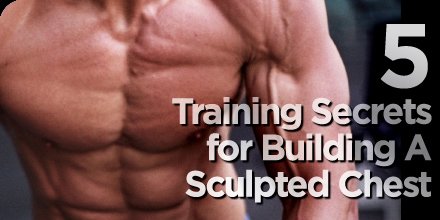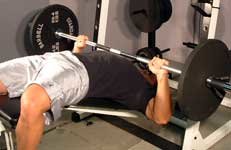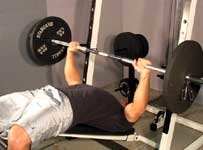| How much can you bench? In this article, I hope to engage and gravitate your attention to some of my secrets to building an impressive chest! Take action now and build a sculpted chest with these tips and exercises! |

How much can you bench? This is the all-to common question we all know to be used as a gauge of total body strength or manhood. However, in this article, I hope to engage and gravitate your attention to some of my secrets to building a wonderfully sculpted and impressive treasure chest!
Like any treasure chest, one has to dig deep to find it, pun intended! How much one can bench is less important, which may be a relief to many who can not bench as much as their peers. Now, the reason why I am writing on chest training is twofold:
- I love writing and sharing my ideas and research-based standpoints on various topics.
- I felt that more people enjoy training articles because of the immediate practicality of them (i.e. I got a lot of positive feedback from my upper back training article).

 Click Image To Enlarge.
Click Image To Enlarge.I Will Share My Secrets To Building A
Wonderfully Sculpted And Impressive Chest!
The approach to chest training is 5-step process:
- Determine an appropriate strength level that will allow chest development to be seen (chest mass).
- Train chest with enough intensity and volume to induce great definition.
- Hit the chest from different grips and body planes.
- Balance your chest training with back training to be at a ratio of 2-or 3-to-1. In other words, for every chest exercise, you should do 2-3 back exercises.
- Work on your posture and train your rotator cuff. These 4 muscles are so intricate and important in maintaining shoulder health and integrity and allowing one to train chest for a long-time to come.

1. An Appropriate Strength Level For Chest: 
- As opposed to referring to absolute weight values, this only serves to discriminate and bias each individual. We know everyone is different. So how can we come up with a gold standard or bar to set for everyone across the board for determining how much one should be able to bench?
Well, contrary to popular opinion, I like to use relative strength as a gauge. Research has shown that in a sample of Caucasian males aged 20-29, 1.48 or greater is the 90th percentile, while 1.06 is average (Cooper Institute for Aerobics Research, 1994). 1.48 (ratio derived from 1RM/bodyweight; i.e. 160 lb male/240 1RM bench press = 1.5).
The number declines slightly with age. However, the point is that a 200 lb man who can bench 315 lbs is weaker than a 140 lb man who can bench 225 lbs. Now we have a level playing field with regard to how much one can bench, and also, you might want to take a look at the impressiveness of the 140 lb guy's chest in comparison to the 200 lb guy's chest.
In all probability, the 140 lb guy's chest will have striations and upper-lower pectoral separation, whereas the 200 lb guy will likely have one blob of chest mass and no kind of striations. Muscle density (quality) is more impressive than muscle mass (quantity).
- Don't concern yourself with the big chests in muscle magazines of guys who are likely not natural, but focus on your own training and do it the right way. You will never go wrong.

2. Intensity Vs. Volume: 
- Which is better? I'd say both are equally as important. Be sure to have high-volume chest workouts and low-volume chest workouts. Hormonally, both will elicit favorable adaptations; low-volume high-load training will induce a nice testosterone response (Kraemer, 2000), while high-volume, low-moderate load training will induce a nice growth hormone response (Kraemer et al., 1993).
Use the shock principle too (Schwarzenegger, 1998). For example, pre-fatiguing the chest will make it work harder. A sample routine would be starting your workout with dumbbell chest flyes for 2-3 sets, and then doingbarbell or dumbbell bench press.


 Click Image To Enlarge.
Click Image To Enlarge.Dumbbell Flyes.
- This will overload your chest by having it continue to work while fatigued, while the triceps will assist in carrying the chest muscles through the exercise.
I know from personal experience this routine works wonders. I know because many of you probably have experienced more anterior deltoid soreness on many occasions after a typical chest workout. However, after this pre-fatigue workout, I was not sore in the delts at all, but my chest was sore!
Another routine could be super-slow reps. Research has shown this type of training to certainly have positive effects on strength and metabolic rate (Hutchins, 1992; Ward, 2004; Westcott et al., 2001).
- I personally find this type of training to really be great at carving up that chest. It's like digging in the sand for the treasure chest, with super-slow reps with a light-moderate weight; you will definitely need to dig in, for that kind of intensity.
The basis of slow-rep training is that it forces you to focus more on perfecting your technique and feeling all the little things occurring physiologically that go unnoticed throughout the normal ROM at traditional rep speed. However, in the end, you will eventually discover that you have finally gotten that treasure chest!
 | ||
| ROM: ROM is an acronym for Range Of Motion. | ||
 3.
3.
Flat, Incline Or Decline? 
- Flat or decline are the best choices when it comes to chest development. Just because the incline bench was invented way back when doesn't make this exercise an immune exercise to biomechanical scrutiny.
Research has shown that there is no significant difference in upper pectoral recruitment between incline or decline bench, however the lower pectorals are activated more in the decline bench (Barnett et al., 1995; Glass & Armstrong, 1997).
In fact, I will give you a simple test that will impress on you why I don't like incline bench. Lie on an incline bench, and without any weights, hold your arms out in front of you in the plane of the bar path. Now hold your arms like this exactly, and stand up.


 Click To Enlarge.
Click To Enlarge.
Decline Barbell Bench Press.
Video : Windows Media - MPEG - Video iPod
- If you've done this correctly, you will notice your arms are basically at a 45 degree angle above your shoulders. What this means is, you are simply using mainly your anterior deltoid in this exercise, and your rotator cuff is getting hammered because your arms are away from your midline, which decreases mechanical leverage.
Not to mention, your arms are above shoulder level, which is conducive to the all-too common shoulder impingement syndrome many weightlifters suffer from nationwide (Gross et al., 1993).
 | ||
| Shoulder Impingement Syndrome: Impingement syndrome, also called painful arc syndrome, supraspinatus syndrome, swimmer's shoulder, and thrower's shoulder, is a clinical syndrome which occurs when the tendons of the rotator cuff muscles become irritated and inflamed as they pass through the subacromial space, the passage beneath the acromion. This can result in pain, weakness and loss of movement at the shoulder. | ||
- "So I don't care what you just said about incline bench, I still want to do it!" Well for those who thought this, I have a solution or a nice compromise.
You could still do incline, but bring the bar to nipple or slightly below nipple line and keep the elbows lower than the shoulder. Also, you could dounderhand grip bench or you could do close-grip neutral grip incline dumbbell bench press.
The point is, shoulder flexion motion (front dumbbell raises) recruits the upper pecs more than horizontal shoulder adduction motion (typical T-bar bench press). I personally like flat and decline for great chest development and maintenance of healthy shoulders.
- Actually, research clearly supports my opinion, since it was found that the clavicular fibers of the chest are recruited greatest with a narrow-hand spacing and anterior deltoid activity tends to increase as trunk inclination increases (Barnett et al., 1995).

4. Muscle Balance: 
- You see many guys walking around with hunched or rounded shoulders. This is a common thing for guys who work chest but neglect back training. In fact, research suggests that a person with bad posture (rounded shoulders) is at greater risk of shoulder problems (Borstad, 2006).
To get a bigger chest, work your upper back. Not only will this create balance, but it will actually create nice side-view depth and make your chest look even bigger! Additionally, back training will actually strengthen your bench, improve your posture and prevent shoulder problems down the road (Barlow et al., 2002).

 Click Image To Enlarge.
Click Image To Enlarge.To Get A Bigger Chest,
Work Your Upper Back.

5. Rotator Cuff & Posture: 
- If you want to have a nice chest and be injury-free, one should definitely train the internal foundation. Anyone can build a fancy house, but the one with a solid foundation will look fancy for a longer period of time. This is analogous to having a nice chest and avoiding shoulder problems.
The rotator cuff gets worked hard during the bench press or dumbbell bench press. Reason being, the pectoralis major is not just a horizontal shoulder adductor, but it is also an internal rotator (Hamill & Knutzen, 2003). The rotator cuff has to stabilize against this big internal rotator moment by externally rotating in an effort to bring the shoulder back into neutral position.
- If you watch someone taking bench press to muscle failure, you will see the elbows bow backward. You may think, "oh he's just working hard and cheating a little." Not exactly. Actually, his pectoralis major and minor are fatigued and are trying to maximize biomechanical efficiency by performing their other function: internal rotation.
- The Rotator Cuff: Injury Prevention! - By Dorian Kent
- The Rotator Cuff - Surgery? - By Ryan Mclane
- The Dangers Of Dumbbell Flyes! - By Matt Danielsson
- Other Rotator Cuff Articles...
Related Rotator Cuff Articles:
What happens is, nothing really. But over time, you will see this person grabbing at his shoulder between sets with a look of misunderstanding on his face. What that misunderstanding is, is this guy being upset and wanting to blame someone or something else for preventing him from enjoying a good chest workout.
Instead, he should hire a qualified personal trainer and learn how to bench correctly and how to balance his chest with appropriate back training, and last but not least, learn how to train, strengthen and stretch his rotator cuff muscles.

 Click Image To Enlarge.
Click Image To Enlarge.Stretch And Strengthen Your
Rotator Cuff Muscles.

Best Chest Mass Exercise
- Barbell Bench Press Or Dumbbell Bench Press:
- 3 sets of 1 rep
- Rest-pause training
- 75-85% 1RM
- Followed by 3 sets of 6-10 reps
- 3 sets of 2-4 reps
- Drop-set training
- 80-85-90% 1RM
- 3 sets of 5-10 reps
- 70-90% 1RM
- Followed by 1 set of pushups to failure
- Regimin 1:
Regimin 2:
Regimin 3:
| 1 REP MAX CALCULATOR |

Best Chest Definition Exercise
- Dumbbell Flyes/Cable Flyes Combo Or Iso-Tension Cable Flyes:
- Dumbbell Flyes/Cable Flyes Combo
- 3 sets of 5-10 reps
- Iso-Tension Cable Flyes
- 3 sets of 8-12 reps
- Hold for 2-5 seconds in each rep
Regimen 1:
Regimen 2:
 | ||
| Iso-Tension: Iso means - Equal; the same, and Tension means - To tighten; stiffen; contract. So Iso-Tension is simply contacting the muscles and holding it in the same place - no movement. | ||

Getting The Chest Absolutely Shredded With Detail/Definition Training
The key to getting the chest ripped in my personal experience is by increasing the total work done and hitting it from every angle possible.
This involves doing more sets and reps and changing grips, body position, and arm position. Stick to rep ranges of 6-10 reps for the first of 1 or 2 exercises for chest, then gradually begin increasing the reps to 10-15, to 15-20, and then finish with 1 or 2 exercises of 50 or more reps! The workout should look something like this:
- Barbell or Dumbbell Bench Press: 3 sets of 3-5 reps
- Dumbbell or Cable Flyes: 3 sets of 8-10 reps
- Pushups: 3 sets of 20-50 reps



